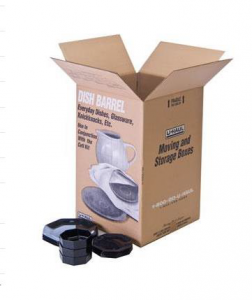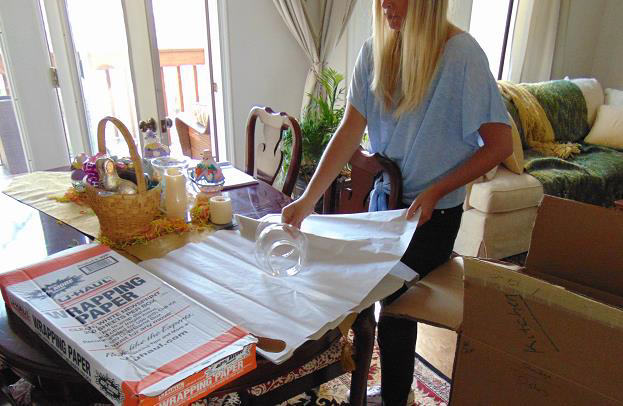HOW TO PACK A DISBARREL® BOX
The Dish Barrel® box, Figure 2.6, is a large, deep box (28 inches high) designed to hold dishes and glassware from the kitchen and from dining room hutches. The Dish Barrel is ‘thicker’ than the other boxes, and is reinforced to both protect and hold the weight of dishes and glassware. The Dish Barrel is the exception to the rule about not putting heavy items into a large box. In fact, the whole purpose of the Dish Barrel is to load it up so that it ends up being very, very heavy. This box is rated for up to 120 pounds. Why the heavy box? By wrapping dishes and

Figure 2.6: The “Dish Barrel” specialty box
Source: www.uhaul.com
glassware in wrapping paper, and loading the items into the Dish Barrel, the items will not move during transport and will stay protected from breakage. Also, the Dish Barrel ends up being so heavy, that it is loaded on the floor of the truck, and other items are stacked on top.
Begin by assembling one of the Dish Barrel boxes by taping together the bottom flaps. Take a box of wrapping paper from the Command Center and place it on the Dining Room Table. (Make sure the table has a protective covering over it). You will use the Dining Room Table to wrap up the individual items from the Hutch and place them into the Dish Barrel box. I love the Dish Barrel. Take a minute and compare the thickness of the box to another small or large box. Notice how the sides are twice as thick? This box is designed to protect glass items from breakage.
Be sure to line the bottom of the box with crinkled up balls of wrapping paper. Now begin the process of wrapping each item, as shown in Figure 10.5. Start with heavier items, like glass bowls, or heavy glasses. Wrap up each item, using two sheets of wrapping paper per item. Place each item into the box, and continue the process. Load the glasses in the upright position, and not laying on their side. As you reach the top of the box, place a final layer of crinkled up wrapping paper balls along the top, then close the top flaps and seal the box shut. Mark the outside of the box with your name and “Dining Room – Top Hutch glasses.”

Figure 10.5: Wrapping Dining Room Hutch Items
Even stemware glasses can be packed and loaded using the same technique. Use two pieces of wrapping paper, and load the stemware toward the top of the box.
After the top hutch is empty, move to the bottom hutch and pack up all those items, once again using a Dish Barrel box. In general, start with the largest, heaviest items, and wrap those up first. They go on the bottom of the box, on top of the layer of crinkled paper balls. Then keep adding items, saving the lightest items for the top. Be sure to use two pieces of wrapping paper per item. The bottom hutch may contain plates and silver utensils. Wrap each plate with two pieces of wrapping paper, and load the plates standing on edge, NOT flat. If silverware is in a wooden box, place the entire box, wrapped in paper, into the Dish Barrel, toward the bottom. For any loose silverware, bundle it up and wrap the bundles in wrapping paper. Place a final layer of crinkled wrapping paper balls along the top layer of the box, then tape the top flaps closed. Mark the outside of the box with your name and “Dining Room – Bottom Hutch.”
OK, great job. You have packed up all your fragile glass items from the Dining Room Hutch into a couple of Dish Barrel boxes. Be sure to update the Inventory Checklist if you ended up using more than two Dish Barrel boxes. And if you only filled up a half of a Dish Barrel, we will add some kitchen items later on.
Do you notice how very heavy the Dish Barrel box is? That is deliberate. The Dish Barrel is designed to be heavy, it is rated to 125 pounds. The box is designed to protect the contents from shifting. When loading the truck, the Dish Barrel will be loaded on the bottom of the tiers, and other items will be loaded on top. Again, in 30 years of moving, I have never seen a broken glass item from a properly packed Dish Barrel. For now, move the sealed Dish Barrel against the Dining room wall until loading day.
